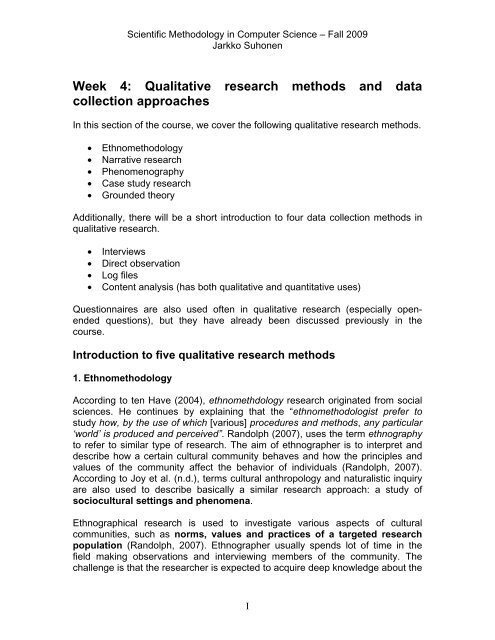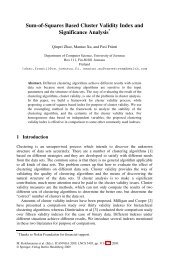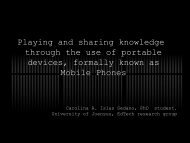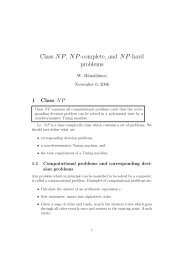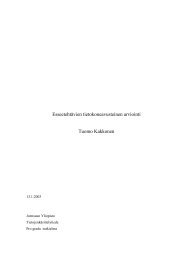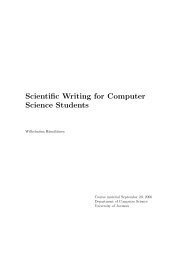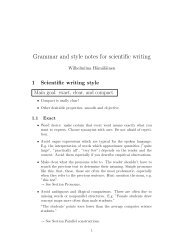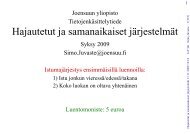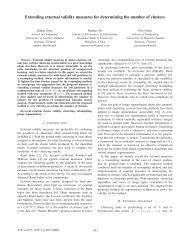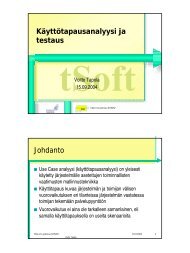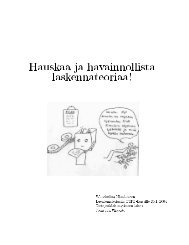Week 4: Qualitative research methods and data collection ... - Joensuu
Week 4: Qualitative research methods and data collection ... - Joensuu
Week 4: Qualitative research methods and data collection ... - Joensuu
You also want an ePaper? Increase the reach of your titles
YUMPU automatically turns print PDFs into web optimized ePapers that Google loves.
Scientific Methodology in Computer Science – Fall 2009Jarkko Suhonen<strong>Week</strong> 4: <strong>Qualitative</strong> <strong>research</strong> <strong>methods</strong> <strong>and</strong> <strong>data</strong><strong>collection</strong> approachesIn this section of the course, we cover the following qualitative <strong>research</strong> <strong>methods</strong>.• Ethnomethodology• Narrative <strong>research</strong>• Phenomenography• Case study <strong>research</strong>• Grounded theoryAdditionally, there will be a short introduction to four <strong>data</strong> <strong>collection</strong> <strong>methods</strong> inqualitative <strong>research</strong>.• Interviews• Direct observation• Log files• Content analysis (has both qualitative <strong>and</strong> quantitative uses)Questionnaires are also used often in qualitative <strong>research</strong> (especially openendedquestions), but they have already been discussed previously in thecourse.Introduction to five qualitative <strong>research</strong> <strong>methods</strong>1. EthnomethodologyAccording to ten Have (2004), ethnomethdology <strong>research</strong> originated from socialsciences. He continues by explaining that the “ethnomethodologist prefer tostudy how, by the use of which [various] procedures <strong>and</strong> <strong>methods</strong>, any particular‘world’ is produced <strong>and</strong> perceived”. R<strong>and</strong>olph (2007), uses the term ethnographyto refer to similar type of <strong>research</strong>. The aim of ethnographer is to interpret <strong>and</strong>describe how a certain cultural community behaves <strong>and</strong> how the principles <strong>and</strong>values of the community affect the behavior of individuals (R<strong>and</strong>olph, 2007).According to Joy et al. (n.d.), terms cultural anthropology <strong>and</strong> naturalistic inquiryare also used to describe basically a similar <strong>research</strong> approach: a study ofsociocultural settings <strong>and</strong> phenomena.Ethnographical <strong>research</strong> is used to investigate various aspects of culturalcommunities, such as norms, values <strong>and</strong> practices of a targeted <strong>research</strong>population (R<strong>and</strong>olph, 2007). Ethnographer usually spends lot of time in thefield making observations <strong>and</strong> interviewing members of the community. Thechallenge is that the <strong>research</strong>er is expected to acquire deep knowledge about theI
Scientific Methodology in Computer Science – Fall 2009Jarkko Suhonencommunity under study, while at the same time take distance in order to makeobjective observations. Additionally, a blend of various <strong>data</strong> <strong>collection</strong> <strong>methods</strong>can be used, e.g. historical <strong>data</strong>, document analysis <strong>and</strong> interviews to supportthe field notes. Ethnographic <strong>research</strong> is often not concerned about individuals<strong>and</strong> their subjective opinions <strong>and</strong> behavior, but activities of the whole community(ten Have, 2004).Example of ethnography in computer scienceMillen, D. R. (2000). Rapid ethnography: time deepening strategies for HCI field<strong>research</strong>. In Proceedings of the 3rd Conference on Designing interactiveSystems: Processes, Practices, Methods, <strong>and</strong> Techniques (New York City, NewYork, United States, August 17 - 19, 2000). D. Boyarski <strong>and</strong> W. A. Kellogg, Eds.DIS '00. ACM, New York, NY, 280-286. DOI=http://doi.acm.org/10.1145/347642.347763“Field <strong>research</strong> <strong>methods</strong> are useful in the many aspects of Human-ComputerInteraction <strong>research</strong>, including gathering user requirements, underst<strong>and</strong>ing<strong>and</strong> developing user models, <strong>and</strong> new product evaluation <strong>and</strong> iterativedesign. Due to increasingly short product realization cycles, there has beengrowing interests in more time efficient <strong>methods</strong>, including rapid prototyping<strong>methods</strong> <strong>and</strong> various usability inspection techniques. This paper will introduce"rapid ethnography," which is a <strong>collection</strong> of field <strong>methods</strong> intended toprovide a reasonable underst<strong>and</strong>ing of users <strong>and</strong> their activities givensignificant time pressures <strong>and</strong> limited time in the field. The core elementsinclude limiting or constraining the <strong>research</strong> focus <strong>and</strong> scope, using keyinformants, capturing rich field <strong>data</strong> by using multiple observers <strong>and</strong> interactiveobservation techniques, <strong>and</strong> collaborative qualitative <strong>data</strong> analysis. A short casestudy illustrating the important characteristics of rapid ethnography will also bepresented.”Table 1 summarise the pros <strong>and</strong> cons of ethnomethodology.Table 1: Strengths <strong>and</strong> weaknesses of ethnomethodologyStrengthsWeaknesses+ ability to examine complex culturalphenomena+ orientation towards holisticperspective <strong>and</strong> tendency to identifydiverse aspects of culture- ethnomethodology’s status as ascience.- whether to focus universal knowledgeor specific knowledge- validity of the reports- needs skillful <strong>research</strong>er <strong>and</strong> lot oftime in the fieldII
2. Narrative <strong>research</strong>Scientific Methodology in Computer Science – Fall 2009Jarkko SuhonenAccording to R<strong>and</strong>olph (2007), narrative <strong>research</strong> is the study of a singleindividual <strong>and</strong> his or her life experiences. In narrative <strong>research</strong>, individuals areasked to provide stories about their live experiences (Joy et al., n.d). The storiescan reveal versatile insights about feelings, sentiments, desires, thoughts, <strong>and</strong>meanings of the person. A life story is a narrative or several narratives influencedby the cultural conventions of telling, by the audience, <strong>and</strong> by the social context(Moen, 2006). He argues that storytelling is a natural way of recounting <strong>and</strong>creating order to our experience, which starts in childhood <strong>and</strong> continues throughall stages of our lives.Moen (2006) <strong>and</strong> Andrews et al. (2004) provide four claims for using narrative<strong>research</strong>1) that human beings organize their experiences of the world into narratives2) concerns the multivoicedness that occurs in the narratives.3) it can be applied in many fields, such as arts, humanities, science <strong>and</strong> socialsciences.4) can be used to investigate how people frame, remember <strong>and</strong> report theirexperiences, thus, allowing <strong>research</strong>ers to get an underst<strong>and</strong>ing of complexitiesof human lives <strong>and</strong> endeavors.In narrative <strong>research</strong>, the <strong>research</strong>er draws conclusions from the various sourcesrelated to individual’s life events. Typical <strong>data</strong> sources in narrative <strong>research</strong> are(Moen 2006)1) interviews2) field notes3) observations4) documents5) biographies6) oral histories <strong>and</strong> story telling.7) newsletters, rules, principles <strong>and</strong> picturesBiographies are one of the most popular <strong>data</strong> <strong>collection</strong> <strong>methods</strong> in narrative<strong>research</strong>, e.g. the individuals are interviewed or they provide a written biographyof their life events based on the topic of the <strong>research</strong>. Rosenthal (2004) providesthe following list of suggestions for a biography1) address a phase of the interviewee’s life2) address a single theme in the interviewee’s life3) address a specific situationsIII
Scientific Methodology in Computer Science – Fall 2009Jarkko Suhonen4) elicit a narration to clarify an earlier argument5) address an event that is not experienced by the interviewee or theknowledge is transmittedRosenthal (2004) also summarises the general steps of narrative <strong>research</strong>analysis1) analysis of the biographical <strong>data</strong>2) text <strong>and</strong> semantic field analysis3) reconstruction of the life history4) microanalysis of individual text segments5) constrastive comparison of biographical <strong>data</strong> <strong>and</strong> life story6) development of types <strong>and</strong> constractive comparison of several casesExample of narrative <strong>research</strong> in computer scienceKnobelsdorf, M. (2009). A Typology of CS Students’ Preconditions for Learning.Proceedings of the 8th Koli Calling International Conference on ComputingEducation Research. Retrieved September 10, 2009 fromhttps://www.it.uu.se/<strong>research</strong>/publications/reports/2009-004/2009-004.pdfKnobelsdorf (2009) has used biographical <strong>research</strong> approach to analyzestudents’ individual computing experiences retrospectively. The main focus of the<strong>research</strong> was to investigate students’ experiences <strong>and</strong> opinions about learning,experiencing <strong>and</strong> underst<strong>and</strong>ing computer science. The main finding of the studywas that students’ computing experiences are individual <strong>and</strong> vary considerably.However, there are some common experiences, beliefs <strong>and</strong> perceptions aboutthe subject. Based on the results of the <strong>research</strong>, the aim is to reconstruct atypology to present typical patterns among the single characteristics of students’preconditions.3. PhenomenographyThe goal of phenomenography is to investigate individuals’ level ofunderst<strong>and</strong>ing of a lived experience or a certain phenomena (R<strong>and</strong>olph, 2007).A phenomenographical <strong>research</strong>er analyses shared meaning of experience of aphenomenon for several individuals. A typical <strong>data</strong> <strong>collection</strong> method inphenomenography is to interview individual who have experienced the liveexperience or the phenomenon. According to Joy et al. (n.d.) this relatively recentmethodology (in computer science) offers a humanistic <strong>and</strong> individualisticinterpretation of the world. In recent year, phenomenography has gainedpopularity in Computer Science Education. The focus has been, for instance, toinvestigate how computer science students underst<strong>and</strong> certain key topics in thefield, such as object-oriented programming concepts.IV
Scientific Methodology in Computer Science – Fall 2009Jarkko SuhonenMarton (2004) presents the following applications for phenomenography1) The experience of learning; investigating the experience of the act oflearning <strong>and</strong> problems solving. Underst<strong>and</strong>ing of the phenomenon of learningfrom learner’s perspective2) Different ways of underst<strong>and</strong>ing the content learned; finding criticaldifferences on how concepts, principles <strong>and</strong> content in specific domains areunderstood. To find out how the development of knowledge <strong>and</strong> skills within adomain can be facilitated3) Describing conceptions of the world around us; characteristing thecollective mind <strong>and</strong> encompassing the different ways people are making sense ofthe worldExample of a <strong>research</strong> paperPears, A., Berglund, A., Eckerdal, A., East, P., Kinnunen, P., Malmi, L.,McCartney, R., Mostrom, J.-E., Murphy, L., Ratcliffe, M.B., Schulte, C., Simon,B., Stamouli, I. <strong>and</strong> Thomas, L. (2007). What's the problem? Teachers'experience of student learning successes <strong>and</strong> failures. In Proc. Seventh BalticSea Conference on Computing Education Research (Koli Calling 2007), KoliNational Park, Finl<strong>and</strong>. CRPIT, 88. Lister, R. <strong>and</strong> Simon, Eds. ACS. 207-211.AbstractThis paper opens the classroom door to provide insight into factors that shapetertiary computer science teachers' experience of (<strong>and</strong> engagement with)student learning success <strong>and</strong> failure. This topic is explored throughphenomenographic analysis of teacher narratives dealing with frustration <strong>and</strong>success in facilitating learning for their students. Three themes related to learningare explored which highlight different aspects of the learning situation, namely,students, environment, <strong>and</strong> responsibility. Using these themes as a focusreveals great diversity in the manner in which teachers experience studentlearning difficulties <strong>and</strong> approaches to resolving them. The results providecomputer science academics with a framework within which to discuss <strong>and</strong>contrast their values <strong>and</strong> assumptions <strong>and</strong> underst<strong>and</strong> their implications forteaching practice.Examples of categorieshttp://crpit.com/confpapers/CRPITV88Pears.pdfV
Scientific Methodology in Computer Science – Fall 2009Jarkko Suhonen4. Case study <strong>research</strong>A case study <strong>research</strong> involves a detailed analysis of a single object orphenomena such as a person, a system, an organization, a course or a group(Jot et al., n.d.). Although, the phenomena under investigation is not completelycontrolled by the <strong>research</strong>ers, the case study <strong>research</strong> can provide relevantknowledge about a complex phenomena within its real life context (Baxter <strong>and</strong>Jack, 2008). The aims of a case study <strong>research</strong> are to gain an in-depthunderst<strong>and</strong>ing of a case <strong>and</strong> the interaction between the phenomenon <strong>and</strong>the case (R<strong>and</strong>olph, 2007). In a case study <strong>research</strong>, several sources of <strong>data</strong>,such as documents, observations, interviews are used to get a deepunderst<strong>and</strong>ing of the case. The typical <strong>data</strong> analysis <strong>methods</strong> are patternmatching,content analysis, <strong>and</strong> finding complementary cases.Baxter <strong>and</strong> Jack (2008) refer to Yin (2003) when describing when to use casestudy <strong>research</strong>:a) the aim is to answer “how” <strong>and</strong> “why” questionsb) the case study <strong>research</strong> can be used to pilot further <strong>research</strong> or testtheoriesc) the <strong>research</strong>er is not able to manipulate <strong>and</strong> control the behaviour of theindividuals.d) contextual factors are highly relevant to the phenomena under study. Forinstance, laboratory settings or controlled tests would not provide natural<strong>and</strong> real results.e) the boundaries between the phenomena <strong>and</strong> context are blurredAccording to Flyvbjerg (2004), the case study is ideal for generalizing in using the“falsification” test, e.g. if just one observation does not fit with the proposition, it isnot considered to be valid in a general sense. The proposition (if it claims to begeneral) must be revised or rejected.Flyvbjerg, B. (2004), presents five main concerns about the nature of case study<strong>research</strong>1) general, theoretical knowledge is more valuable than concrete, practicalknowledge2) since one cannot generalize from an individual case, the case studycannot contribute to the scientific developmentVI
Scientific Methodology in Computer Science – Fall 2009Jarkko Suhonen3) the case study is most useful for generating hypothesis4) the case study contain a bias towards verification; e.g. tendency to confirm<strong>research</strong>er’s notions5) it is difficult to summarise <strong>and</strong> develop general theories on the basis of aspecific case studyData selection in case study <strong>research</strong>The objective in case study <strong>research</strong> is to collect as much information about the<strong>research</strong> problem or phenoemena under study. According to Flyvbjerg (2004),<strong>collection</strong> of a representative or r<strong>and</strong>om sample might not be the mostinformative. Atypical <strong>and</strong> extreme cases reveal often more interesting information(for instance unexpected results) than r<strong>and</strong>om or typical cases.Table 2 summarise the strategies to increase the information gain in case study<strong>research</strong>. Similarly, the same criteria can be used in other qualitative <strong>methods</strong> tosupport the decision on <strong>data</strong> selection.Table 2: Different case selection criteriaStrategyPurposeR<strong>and</strong>om sampleTo avoid biases in the sample. The samplesize is important for generalization.Stratified sampleTo generalize for sub-groups within thepopulationExtreme/deviant casesTo obtain information about unusual casesMaximum variation cases To obtain information from cases that differfrom each otherCritical casesTo achieve information about a case that hasa strategic importance to the problem. Thecase of falsification.Paradigmatic casesTo develop a metaphor for the domain thatthe case concernsPros <strong>and</strong> cons of case studiesTable 3 summarizes the strengths <strong>and</strong> weaknesses of case studies (Joy et al.,n.d.)Table 3: Strengths <strong>and</strong> weaknesses of case studiesStrengthsWeaknesses+ results are easy to disseminate to a - generalizations cannot be madeVII
Scientific Methodology in Computer Science – Fall 2009Jarkko Suhonennon-technical audience+ observation of the effect of a “realcontext”+ comparison between similar cases<strong>and</strong> situationseasily.- cannot be reproduced easily (or evenverified)- there may be observer bias.The following example gives an insight how case studies could be used incomputer science.Example of a case study <strong>research</strong> in computer scienceLayman, L., Williams, L., <strong>and</strong> Cunningham, L. 2004. Motivations <strong>and</strong>measurements in an agile case study. In Proceedings of the 2004 Workshop onQuantitative Techniques For Software Agile Process (Newport Beach, California,November 05 - 05, 2004). QUTE-SWAP '04. ACM, New York, NY, 14-24. DOI=http://doi.acm.org/10.1145/1151433.1151436“With the recent emergence of agile software development technologies, thesoftware community is awaiting sound, empirical investigation of the impacts ofagile practices in a live setting. One means of conducting such <strong>research</strong> isthrough industrial case studies. However, there are a number of influencingfactors that contribute to the success of such a case study. In this paper, wedescribe a case study performed at Sabre Airline Solutions evaluating theeffects of adopting Extreme Programming (XP) practices with a team thathad characteristically plan-driven risk factors. We compare the team's businessrelatedresults (productivity <strong>and</strong> quality) to two published sources of industryaverages. Our case study found that the Sabre team yielded above-averagepost-release quality <strong>and</strong> average to above-average productivity. We discussour experience in conducting this case study, including specifics of how <strong>data</strong>was collected, the rationale behind our process of <strong>data</strong> <strong>collection</strong>, <strong>and</strong> whatobstacles were encountered during the case study. We also identify fourfactors that potentially impact the outcome of industrial case studies: availabilityof <strong>data</strong>, tool support, co-operative personnel <strong>and</strong> project status. We believethat recognizing <strong>and</strong> planning for these factors is essential to conductingindustrial case studies, <strong>and</strong> that this information will be helpful to <strong>research</strong>ers <strong>and</strong>practitioners alike.”VIII
Scientific Methodology in Computer Science – Fall 2009Jarkko Suhonen5. Grounded TheoryAccording to Dunican (2006) <strong>and</strong> R<strong>and</strong>olph (2007), grounded theory is aninductive qualitative <strong>research</strong> method where the theory or models emerge fromthe <strong>data</strong> via a spiral <strong>research</strong> process, e.g. the theory is said to be “grounded” tothe <strong>research</strong> context. R<strong>and</strong>olph refers to Creswell (2007) stating that groundedtheory is appropriate when there is no existing theory related to the phenomenaor the existing theories are not complete.According to Dey (2004) there is not a single unified, well-defined method called“grounded theory”, but different interpretations of grounded theory from the earlydevelopers Glasser <strong>and</strong> Straub to the recent variations. However, there are alsocommonalities.• Primary purpose: create theory from the <strong>data</strong>• Research <strong>data</strong>: relies mainly on qualitative (can also be quantitative) <strong>data</strong>acquired through a variety of <strong>methods</strong>, such as observations, interviews<strong>and</strong> document analysis (Dunican, 2006). The <strong>data</strong> <strong>collection</strong> becomesmore structured as the study progresses.• Selection of <strong>data</strong>: theoretical sampling of <strong>data</strong> based on the potentialcontribution to the development of theory• Data analysis process: coding the <strong>data</strong> into categories, which representthe key aspects of the <strong>data</strong>. The <strong>data</strong> <strong>collection</strong> stops in grounded theorywhen the categories reach saturation, e.g. the <strong>research</strong>er is no longercapable of creating new categoriesThe coding process consists of the following phases1) identification of categories in <strong>data</strong>. Open coding is used to examine thetext for items of interest, with the ultimate aim of accumulating codes intocategories.2) building relationships between categories. A <strong>research</strong>er uses acomparative approach where he/she constantly compares new instancesof the category with those already encountered until he/she saturates thecategory (i.e. no new insights in the category can be gained from the<strong>data</strong>).3) grouping the categories together to form theoretical constructs. The netoutcome of grounded <strong>research</strong> is a theory that contains a centralphenomenon, its causal conditions, its intervening conditions <strong>and</strong> itsconsequencesIX
Scientific Methodology in Computer Science – Fall 2009Jarkko SuhonenAn important part of the <strong>research</strong> process is to decide when enough <strong>data</strong> hasbeen coded. When multiple behavior occur, the <strong>data</strong> is said to be saturated. GThas similarities to case study <strong>research</strong> <strong>and</strong> ethnography, since both the latter aimto detect <strong>and</strong> interpret patterns within activities <strong>and</strong> events (de Villiers, 2005).Criteria for well-constructed grounded theory1) the categories <strong>and</strong> properties should fit into the reality being studied2) the theory should explain variations in the phenomena3) the emerging theory is open to adaptation as new <strong>data</strong> is integrated4) <strong>data</strong> <strong>collection</strong>, analysis <strong>and</strong> presentation to peers should be linked ateach stepPossible application areas in computer science• to study organizational structures <strong>and</strong> experiences in order todevelop new technologies• to the development of software of non-st<strong>and</strong>ard interactiveenvironment, such as culturally sensitive <strong>and</strong> contextulised e-learning (de Villiers, 2005a)• to study the interaction of users with new technological innovations,such as tangible technologiesTable 4 summarises pros <strong>and</strong> cons of grounded theory <strong>research</strong> method.Table 4: Strengths <strong>and</strong> weaknesses of grounded theoryWeaknesses- overwhelming amount of <strong>data</strong> =>difficult to manageStrengths+ identifies the situated nature aknowledge, as well as the contingentnature of practice+ produces a 'rich' or 'thick' descriptionthat properly acknowledges areas ofconflict <strong>and</strong> contradiction.+ more likely to determine what actuallyhappensMore information about grounded theoryhttp://en.wikipedia.org/wiki/Grounded_theoryExample of grounded theory in Computer Science- investigator needs to be well skilledwith the method (R<strong>and</strong>olph, 2007)- no st<strong>and</strong>ard rules to follow• identification of categories• saturation of <strong>data</strong>X
Scientific Methodology in Computer Science – Fall 2009Jarkko SuhonenRazavi, M. N. <strong>and</strong> Iverson, L. 2006. A grounded theory of information sharingbehavior in a personal learning space. In Proceedings of the 2006 20thAnniversary Conference on Computer Supported Cooperative Work (Banff,Alberta, Canada, November 04 - 08, 2006). CSCW '06. ACM, New York, NY,459-468. DOI= http://doi.acm.org/10.1145/1180875.1180946This paper presents a grounded theory of information sharing behavior of theusers of a personal learning space. A personal learning space is an environmentconsisted of weblog, ePortfolio, <strong>and</strong> social networking functionality. It is primarilyused within education as a tool to enhance learning, but is also used as aknowledge management tool <strong>and</strong> to develop communities of practice. Our resultsidentify privacy as a main concern for users of a personal learning space<strong>and</strong> illustrate challenges users face in ensuring privacy of their information<strong>and</strong> strategies they employ to achieve the desired level of privacy. We thenidentify factors that affect users' decisions regarding disclosure of their personalartifacts to various people <strong>and</strong> groups in a personal learning space. The threemain themes as emerged in our study include current stage in the informationlife cycle, the nature of trust between the owner <strong>and</strong> the receiver ofinformation, <strong>and</strong> the dynamics of the group or community within which theinformation is being shared. Together, these themes portrayed a clearerpicture of users' perspective on the privacy of their information in a personallearning space. The findings offer some ideas about how to create privacymanagement mechanisms for personal learning spaces that are based on users'mental model of information privacy. Practical implications of the results are alsodiscussed.Data <strong>collection</strong> <strong>methods</strong> in qualitative <strong>and</strong> mixed method<strong>research</strong>InterviewsWhile questionnaires can be used both in quantitative <strong>and</strong> qualitative <strong>research</strong>,interviews are mostly used in qualitative <strong>research</strong> to collect <strong>research</strong> relatedinformation (Cohen, Manion & Morrison, 2000) about• knowledge of the people• opinions, e.g. likes or dislikes• what persons are thinking about• attitudes• motivations.There are different ways on how the interviews can be organized. According to(Cohen, Manion & Morrison, 2000), the following interview types are common:1) Open-ended (unstructured) interviewXI
Scientific Methodology in Computer Science – Fall 2009Jarkko SuhonenIn open-ended interview, the interview process follows an informal conversationpattern. In the beginning of the interview, the interviewee asks general questionsrelated to the <strong>research</strong> topic <strong>and</strong> the following questions are dependent on therespondents’ answers. In an unstructured interview, the aim is not necessary tocover the same topics with all the respondents, but to discuss different topics.The questions can also appear r<strong>and</strong>omly. In open ended interviews, therespondents are able to demonstrate their unique way of looking at thephenomena <strong>and</strong> the interview situation is flexible <strong>and</strong> dynamic. An open-endedinterview can also reveal unexpected <strong>data</strong>.2) Closed (or structured) interviewA structured interview is carefully designed <strong>and</strong> scheduled in order to cover thesame topics with all respondents. The advantage of closed interviews is that thecollected <strong>data</strong> will be more focused compared to open interviews. The <strong>data</strong> willalso most likely include information that is inline with the objective of the<strong>research</strong>.3) Focus group interviewsFocus group interviews are moderated group discussions (with 8-12 people) on aparticular topic/issue (R<strong>and</strong>olph, 2007). Focus groups are useful for gatheringinformation from a group of respondents at one time. A common approach infocus interviews is to invite a group of experts to discuss about the <strong>research</strong>topic. The aim is to get the experts to provide different perspectives to thediscussion. If the focus group interview session is organized correctly, theatmosphere can encourage participants to speak <strong>and</strong> interact spontaneously. Onthe other h<strong>and</strong>, some participants may dominate the conversation or others canfeel uncomfortable in being open in a group situation. It is common that the focusgroup interviews are both recorded on video <strong>and</strong> the <strong>research</strong>er makes notesduring the focus group interview session.XII
Scientific Methodology in Computer Science – Fall 2009Jarkko SuhonenStrengths+ in depth knowledge from therespondents+ flexibility <strong>and</strong> ability to get lot ofuseful information+ allows focusing questionsWeaknesses- time consuming <strong>and</strong> expensive toorganise- respondents may feel uncomfortableto speaking openly to unknowninterviewer – fear of losing the face- respondents are sometimes eager togive answers that in their opinioninterviewer wants to hear- source of bias; interviewer,respondent, <strong>and</strong> questions (Cohen,Manion & Morrison, 2000)- <strong>research</strong>er will have some influenceon the interviewee, which will effect the<strong>data</strong>. For instance, attitudes, opinions<strong>and</strong> expectations of the interviewer canhave effect on the answers.- <strong>data</strong> analysis takes time <strong>and</strong>resources- communication problems:misinterpretation of question <strong>and</strong>answer, poor h<strong>and</strong>ling of difficultinterviews- focus group interviews: how tomotivate the experts to participate <strong>and</strong>how to get the “correct” peopleRecommendations for conducting interviews1) plan interviews carefully• write down list of areas which needs to be covered <strong>and</strong> transform theminto questions, decide on the type of interview• draft the interview schedule, content, wording, format <strong>and</strong> structure• make appointments with respondentsXIII
Scientific Methodology in Computer Science – Fall 2009Jarkko Suhonen2) always try to record the interview3) issues to be remember during an interview session (Cohen, Manion &Morrison, 2000)• use clear, concise <strong>and</strong> precise language• listen carefully to the answers <strong>and</strong> let the respondents freely express theirthoughts• recap some of the respondents answers in order to get an agreement ofthe meaning• maintain eye contact <strong>and</strong> use appropriate body language to create anonjudgmental atmosphere• do not show your own opinions to the respondents• reinforce <strong>and</strong> encourage further comments <strong>and</strong> follow ups• try to create a situation where respondents are sincere, well-motivated<strong>and</strong> both the <strong>research</strong>er <strong>and</strong> the <strong>research</strong> subject feel comfortableExampleAn example of a qualitative <strong>research</strong> interview protocol can be found at:http://www.edu.plymouth.ac.uk/resined/<strong>Qualitative</strong>%20<strong>methods</strong>%202/markedpg.htmDirect observationIn the direct observation method, the <strong>research</strong>er observes people’s normalbehaviour without disturbing the situation. The term “non-intrusive” is also oftenused to describe this method to remind that the <strong>research</strong>er should not intervenewith the <strong>research</strong> settings (R<strong>and</strong>olph, 2007). According to Taylor-Power <strong>and</strong>Steele (1996) suggest that seeing <strong>and</strong> listening are the key aspects of directobservation. The method provides the opportunity to collect such <strong>data</strong> that, forinstance, might be difficult to retrieve via questionnaires or interviews. In somecase, behavior of the people can also be recorded with a video camera.R<strong>and</strong>olph (2007), in direct observation a <strong>research</strong>er directly observes thebehaviour of participants by using commonly the following <strong>methods</strong>1) free form; peering over participant’s should <strong>and</strong> taking notes how aparticipant is behaving2) <strong>research</strong>er operationalise a behavior <strong>and</strong> counts how many times thebehavior occurs over a given period or categorises the eventsXIV
Scientific Methodology in Computer Science – Fall 2009Jarkko SuhonenOne approach is to mix the two <strong>methods</strong>; first perform a pilot study with freerecording <strong>and</strong> then use the results to define the criteria for grouping in a widerstudy (R<strong>and</strong>olph, 2007). Several observers can also be used to increase thereliability of the results. However, when there is more than one observer, it isimportant to reach a level where the observers agree about the recording <strong>and</strong>grouping criteria (e.g. which event belongs to which category). Verbal protocol(e.g. think-a-loud) technique can also be used as a supportive <strong>data</strong> <strong>collection</strong>method in direct observation.Focus of observation (Taylor-Power <strong>and</strong> Steele, 1996)1) characteristics of participants; values, attitudes, skill <strong>and</strong> knowledge levels2) interactions in a social situationso unconscious behavioro level of participationo power relationshipso climate in the <strong>research</strong> settings under study3) nonverbal behavioro facial expressions, gestureso interests <strong>and</strong> commitments4) physical surroundingsExamples of use in Computer Science• requirement capturing• product evaluation, e.g. something physical that can be readibly seen <strong>and</strong>evaluate (Taylor-Power <strong>and</strong> Steele, 1996)• investigation of problem areas with software/other computing equipment• <strong>research</strong> on people’s behavior, for instance, in work places, schools• how students interact with each other when they are using a technologicalinnovation to support collaborative workXV
Scientific Methodology in Computer Science – Fall 2009Jarkko SuhonenStrengths+ <strong>research</strong> participants can beobserved in their natural environmentto collect direct information (Taylor-Power <strong>and</strong> Steele, 1996)+ different kind of conclusion can bemade from the rich <strong>data</strong>+ <strong>research</strong>er can observe behavior ofmore than one person performing acertain task or using the sameequipment => helps to underst<strong>and</strong> anongoing behavior, process or event(Taylor-Power <strong>and</strong> Steele, 1996)+ collect non-verbal information, e.g.anxiety, frustration <strong>and</strong> body language+ first-h<strong>and</strong> experience can becollected of the behavior ofparticipants, individually <strong>and</strong> as a group(R<strong>and</strong>olph, 2007)Weaknesses- people might behave differently (e.g.perform better in tasks) when theyhave been observed, e.g. “Hawthorneeffect”- find an appropriate balance betweenstructure <strong>and</strong> free recording, e.g. toomuch structured observation approachmight limit the unexpected findings- lack of control to the participants- <strong>research</strong>er can get too much involvedinto the <strong>research</strong> settings- the <strong>research</strong>er can misinterpret someof the behavior- requires resources <strong>and</strong> time both fororganization <strong>and</strong> analysis+ gain knowledge about the <strong>research</strong>contextRecommendations for using direct observation (R<strong>and</strong>olph, 2007; Taylor-Power<strong>and</strong> Steele, 1996)• carefully plan the direct observation study in order to ensure commitmentboth from the <strong>research</strong>ers <strong>and</strong> participants <strong>and</strong> to clarify the appropriatefocus => what do you want to know?• observers role should be made clear <strong>and</strong> there should be a clear plantowards the performed observations (what to observe <strong>and</strong> record, whatare the most important aspects, focus on unusual behavior)• it might be also necessary to perform interviews later on to clarify theresults of the observations => it is important to know what isusers/<strong>research</strong> subjects view about credible <strong>and</strong> useful information• for ethical reasons participants should not be observed without beinginformed about the investigation, but on the other h<strong>and</strong> “hidden”observation might reveal more realistic <strong>data</strong>XVI
Scientific Methodology in Computer Science – Fall 2009Jarkko Suhonen• it has been estimated that basic analysis will take at least twice as long asthe length of the material, e.g. with thee hour recording the analysis takesat least six hours (even more in some cases). The reporting of the resultsis also time consuming, so it is estimated that one hour of recordingrequires six times the amount of time for analysis <strong>and</strong> reportingLog filesWith the development of IT, log files has become an alternative <strong>data</strong> <strong>collection</strong>method for <strong>research</strong> in computing. The user-generated <strong>data</strong> in log files can beused, for instance, in educational technology to record how students have beenusing a digital learning environment (R<strong>and</strong>olph, 2007). Log files also enable thatlot of <strong>data</strong> can be collected automatically with low costs. For instance, webservers can automatically record <strong>data</strong> about the visitors in web pages: visitedpages, visitor country, visiting time <strong>and</strong> day, IP address.Examples (R<strong>and</strong>olph, 2007)1. how long users have been using an application2. what features the users have used <strong>and</strong> how often3. how often they have used one feature in conjunction with another4. texts from chart rooms or discussion forumsStrengths+ <strong>data</strong> is captured directly in a digitalform, so there is no need to encode the<strong>data</strong> later on+ the collected <strong>data</strong> is natural <strong>and</strong> the<strong>data</strong> <strong>collection</strong> process is unobtrusive+ any aspects of user’s interaction withan application can be stored+ lot of <strong>data</strong> can be collected atminimum costsWeaknesses- overwhelming amount of <strong>data</strong>- temptation to collect <strong>and</strong> analyse the<strong>data</strong> without permissions (R<strong>and</strong>olph,2007)- reveal only technical aspects, notmeaning, reasons, goals => needsoften additional <strong>data</strong> <strong>collection</strong><strong>methods</strong>Content analysisContent analysis is <strong>data</strong> <strong>collection</strong> method or <strong>research</strong> tool to study the content<strong>and</strong> meaning of texts <strong>and</strong> information resources, such as books, essays,interviews, discussions, historical documents, speeches, conversations, website<strong>and</strong> images (R<strong>and</strong>olph, 2007). Because content analysis can be used to examinebasically any piece of writing or occurrence of recorded communication, it iswidely applied in many disciplines <strong>and</strong> fields of inquiry, such as media studies,literature, cultural studies, psychology, cognitive science <strong>and</strong> computer science.XVII
Scientific Methodology in Computer Science – Fall 2009Jarkko SuhonenStemler (2001) refers to Holsti (1969) to give a broad definition of contentanalysis"any technique for making inferences by objectively <strong>and</strong> systematicallyidentifying specified characteristics of messages”.Content analysis can be used, for instance, to study authorship, authenticity <strong>and</strong>meaning of communication to study who says what, to whom, why, to whatextent <strong>and</strong> with what effect (Stemler, 2001)Examples of content analysis uses include (R<strong>and</strong>olph, 2007; Stemler, 2001)1. reveal cultural differences in communication content2. detect the existence of propag<strong>and</strong>a3. identify the intentions, focus or communication trends of an individual,group or institution4. examine trends <strong>and</strong> patterns in documents5. determine psychological or emotional state of persons or groups. Forinstance, monitoring sifts in public opinions.Stemler (2001) present the following concrete example:A school mission statement were investigated to make interference about whatschools thought was the main primary reason for existence. One of the mainquestions of the study was whether the criteria used to measure theeffectiveness of the program were aligned with the overall program objectives orreasons for existence.Aspects that need to make into consideration (Stemler (2001) referring toKrippendorff (1980))1. What is the <strong>data</strong> that is going to be analysed2. How the <strong>data</strong> is defined?3. What is the population where the <strong>data</strong> is drawn?4. What is the context relative to which the <strong>data</strong> are analysed?5. What are the boundaries?6. What is the objective of the analysis?A general process for content analysis1. Identify the <strong>research</strong> question2. Choose the <strong>data</strong> samples for analysis3. Determine the type of analyses4. Reduce the text to categories <strong>and</strong> code for words <strong>and</strong> patterns5. Explore the relationships between concepts6. Code the relationshipsXVIII
Scientific Methodology in Computer Science – Fall 2009Jarkko Suhonen7. Perform statistical analysis, for instance, to analyse the reliability of theresults8. Map out the representationsDuring a content analysis process, the text is coded, or broken down, intomanageable categories on a variety of levels - word, word sense, phrase,sentence, or theme - <strong>and</strong> then examined using either conceptual analysis orrelational analysis. In the conceptual analysis, the purpose is to identify existence<strong>and</strong> frequency of concepts in a text (R<strong>and</strong>olph, 2007). For instance, one can usethe conceptual analysis to find out how many times certain themes appear indiscussion forum postings. The relational analysis goes one step further byexamining the relationships among concepts in a text.There are basically two coding schemes used in content analysis (R<strong>and</strong>olph,2007)1) a priori coding scheme; existing theory is used to create thecategories <strong>and</strong> the content is analysed based on the categories2) emergent coding scheme; the categories emerge from the content,no previous theory is used to create the categories (compare togrounded theory)In any cases, a coding book should be created to support the analysis process.The coding book depicts the important variables of the study <strong>and</strong> the proceduresof coding the <strong>data</strong>. For instance, the <strong>research</strong>er needs to make explicit thecoding unit of the study (e.g. the smallest entity to be categorized). Examples ofstudy units are natural boundaries of the document, separations used by authors(words, sentences), referential units <strong>and</strong> propositional to infer the underlyingassumptions (Stempler, 2001).McLoughlin, D., Mynard, J. (2009). Innovations in Education & TeachingInternational, Volume 46, Number 2, pp. 147-160.Abstract:This paper describes a study of online discussion forums as tools forpromoting higher-order thinking. The study was carried out in a women'suniversity in the United Arab Emirates. Data, in the form of online discussionforum transcripts, were collected over a 20-week semester <strong>and</strong> were analysedaccording to a model developed by Garrison, Anderson, <strong>and</strong> Archer (2001).Discussion forum postings were analysed for evidence of higher-orderthinking <strong>and</strong> were placed within one of the model's categories of 'triggering','exploration', 'integration', or 'resolution'. The <strong>research</strong>ers did find evidence ofhigher-order thinking processes. The results showed that the majority of postingswere either categorised as 'exploration' or 'integration'. The results alsosupported the notion that the correct conditions need to be present in order forhigher-order thinking to arise. The findings suggested that the initial teacherXIX
Scientific Methodology in Computer Science – Fall 2009Jarkko Suhonenprompt or question may have had a bearing on the nature of learners'postings.http://www.ingentaconnect.com/content/routledg/riie/2009/00000046/00000002/art00004ReferencesAndrews, M., Sclater, S.D., Squire, C., Tamboukou, M. (2004). Narrative<strong>research</strong>. In Sale, C., Gobo, G., Gudrium, F., Silverman D. (Eds.). <strong>Qualitative</strong>Research Practice. Sage Publications.Baxter, P., Jack, S. (2008). <strong>Qualitative</strong> Case Study Methodology: Study Design<strong>and</strong> Implementation for Novice Researchers. The <strong>Qualitative</strong> Report, 13(4).Retrieved September 9, 2009 from http://www.nova.edu/ssss/QR/QR13-4/baxter.pdfCreswell, J.W. (2007). <strong>Qualitative</strong> inquiry & <strong>research</strong> design: Choosing amongfive approaches (2nd Ed.). Thous<strong>and</strong> Oaks, CA: Sage.Cohen, L., Manion, L., Morrison, K. (2000). Research <strong>methods</strong> in education. (5thed.). London: RoutledgeFalmer.Day, I. (2004). Grounded theory. In Sale, C., Gobo, G., Gudrium, F., SilvermanD. (Eds.). <strong>Qualitative</strong> Research Practice. Sage PublicationsDunican, E. (2006). A Framework for Evaluating <strong>Qualitative</strong> Research Methods inComputer Programming Education. In P. Romero, J. Good, E. Acosta Chaparro& S. Bryant (Eds.). Proceedings of the PPIG 17, pp. 255-267.Flyvjberg, B. (2004). Five misunderst<strong>and</strong>ings about case-study <strong>research</strong>. In Sale,C., Gobo, G., Gudrium, F., Silverman D. (Eds.). <strong>Qualitative</strong> Research Practice.Sage PublicationsHolsti, O.R. (1969). Content Analysis for the Social Sciences <strong>and</strong> Humanities.Reading, MA: Addison-Wesley.Johnson, R.B. & Christensen, L. (2007) Quantitative, qualitative <strong>and</strong> mixedapproaches. Retrieved March 23, 2008.Joy, M., Sun, S., Sitthiworachart, J., Sinclair, J. <strong>and</strong> López, J. (n.d). GettingStarted in Computer Science Education Research. Retrieved February 4, 2008from http://www.ics.heacademy.ac.uk/resources/pedagogical/cs_<strong>research</strong>/XX
Scientific Methodology in Computer Science – Fall 2009Jarkko SuhonenKnobelsdorf, M. (2009). A Typology of CS Students’ Preconditions for Learning.Proceedings of the 8th Koli Calling International Conference on ComputingEducation Research. Retrieved September 10, 2009 fromhttps://www.it.uu.se/<strong>research</strong>/publications/reports/2009-004/2009-004.pdfKrippendorff, K. (1980). Content Analysis: An Introduction to Its Methodology.Newbury Park, CA.Layman, L., Williams, L., <strong>and</strong> Cunningham, L. 2004. Motivations <strong>and</strong>measurements in an agile case study. In Proceedings of the 2004 Workshop onQuantitative Techniques For Software Agile Process (Newport Beach, California,November 05 - 05, 2004). QUTE-SWAP '04. ACM, New York, NY, 14-24. DOI=http://doi.acm.org/10.1145/1151433.1151436Lonnberg, J. <strong>and</strong> Berglund, A. (2007). Students' underst<strong>and</strong>ings of concurrentprogramming. In Proc. Seventh Baltic Sea Conference on Computing EducationResearch (Koli Calling 2007), Koli National Park, Finl<strong>and</strong>. CRPIT, 88. Lister, R.<strong>and</strong> Simon, Eds. ACS. 77-86. Retrieved September 13, 2009 fromhttp://crpit.com/confpapers/CRPITV88Lonnberg.pdfMarton, F. (1994). Phenomenography. In Husén, T. & Postlethwaite, T.N. (Eds.)The International Encyclopedia of Education (2nd Ed.). Pergamon 1994, pp.4424-4429. Retrieved September 26, 2009 fromhttp://www.ped.gu.se/biorn/phgraph/civil/main/1res.appr.htmlMiles, M.B., Huberman, A.M. (1994). <strong>Qualitative</strong> <strong>data</strong> analysis: An exp<strong>and</strong>edsourcebook (2nd. Ed.). London: SAGE Publications.Millen, D. R. 2000. Rapid ethnography: time deepening strategies for HCI field<strong>research</strong>. In Proceedings of the 3rd Conference on Designing interactiveSystems: Processes, Practices, Methods, <strong>and</strong> Techniques (New York City, NewYork, United States, August 17 - 19, 2000). D. Boyarski <strong>and</strong> W. A. Kellogg, Eds.DIS '00. ACM, New York, NY, 280-286. DOI=http://doi.acm.org/10.1145/347642.347763Moen, T. (2006), Reflections on the Narrative Research Approach. InternationalJournal of <strong>Qualitative</strong> Methods 5 (4).http://www.ualberta.ca.joecat.joensuu.fi:8080/~iiqm/backissues/5_4/HTML/moen.htmR<strong>and</strong>olph, J.J. (2007). Multidisciplinary <strong>methods</strong> in educational technology<strong>research</strong> <strong>and</strong> development. Retrieved February 9, 2008 fromhttp://justus.r<strong>and</strong>olph.name/<strong>methods</strong>Rosenthal, G. (2004). Biographical <strong>research</strong>. In Sale, C., Gobo, G., Gudrium, F.,Silverman D. (Eds.). <strong>Qualitative</strong> Research Practice. Sage Publications.XXI
Scientific Methodology in Computer Science – Fall 2009Jarkko SuhonenStemler, S. (2001). An overview of content analysis. Practical Assessment,Research & Evaluation, 7(17). Retrieved September 26, 2009 fromhttp://PAREonline.net/getvn.asp?v=7&n=17.ten Have, P. (2004). Ethnomethodology. In Sale, C., Gobo, G., Gudrium, F.,Silverman D. (Eds.). <strong>Qualitative</strong> Research Practice. Sage Publications.Taylor-Power, E., Steele, S. (1996). Collecting evaluation <strong>data</strong>: Directobservation. G3658-5, Program Development <strong>and</strong> Evaluation. University ofWisconsin. Retrieved September 26, 2009 fromhttp://learningstore.uwex.edu/pdf/G3658-5.pdfYin, R. K. (2003). Case study <strong>research</strong>: Design <strong>and</strong> <strong>methods</strong> (3rd ed.). Thous<strong>and</strong>Oaks, CA: Sage.XXII


